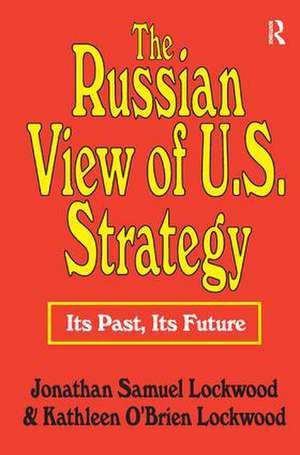The Russian View of U.S. Strategy: Its Past, Its Future
Autor Jonathan Samuel Lockwooden Limba Engleză Hardback – 10 noi 2017
| Toate formatele și edițiile | Preț | Express |
|---|---|---|
| Paperback (1) | 433.68 lei 6-8 săpt. | |
| Taylor & Francis – 30 dec 1969 | 433.68 lei 6-8 săpt. | |
| Hardback (1) | 1000.27 lei 6-8 săpt. | |
| Taylor & Francis – 10 noi 2017 | 1000.27 lei 6-8 săpt. |
Preț: 1000.27 lei
Preț vechi: 1219.84 lei
-18% Nou
Puncte Express: 1500
Preț estimativ în valută:
191.40€ • 200.37$ • 158.37£
191.40€ • 200.37$ • 158.37£
Carte tipărită la comandă
Livrare economică 05-19 aprilie
Preluare comenzi: 021 569.72.76
Specificații
ISBN-13: 9781138538382
ISBN-10: 1138538388
Pagini: 244
Dimensiuni: 152 x 229 x 14 mm
Greutate: 0.45 kg
Ediția:1
Editura: Taylor & Francis
Colecția Routledge
Locul publicării:Oxford, United Kingdom
ISBN-10: 1138538388
Pagini: 244
Dimensiuni: 152 x 229 x 14 mm
Greutate: 0.45 kg
Ediția:1
Editura: Taylor & Francis
Colecția Routledge
Locul publicării:Oxford, United Kingdom
Cuprins
Introduction; 1: Doctrinal Overview; 1: The Development of U.S. Strategic Doctrine; 2: The Evolution of Soviet Strategic Doctrine; 2: Massive Retaliation Period (1954–1960); 3: The Soviet View of Massive Retaliation; 4: Limited War: Can “U.S. Imperialism” Restrain Itself?; 3: Flexible Response Period (1961–1968); 5: Flexible Response and Soviet Reaction; 6: Soviet Reaction to the McNamara Concepts; 4: Realistic Deterrence Period (1969–1982); 7: The Crisis of Capitalism: Soviet Views of the Nixon Doctrine; 8: Dangerous Reversal: Soviet Reaction to the Limited Nuclear Options Strategy; 9: Toward Nuclear Warfighting? The Soviet View of PD 59; 5: From Strategic Defense Initiative To The Collapse Of Communism (1983–1991); 10: Nightmare Becomes Reality: The Soviet View of SDI; 11: The Future of U.S. and Russian Strategy
Descriere
Soviet perceptions of U.S. strategy remained remarkably consistent from the post-Stalin period through the collapse of communism in Eastern Europe and the Soviet Union itself. The consistency of the Soviet tendency to engage in the 'mirror-image' fallacy in their analyses of U








